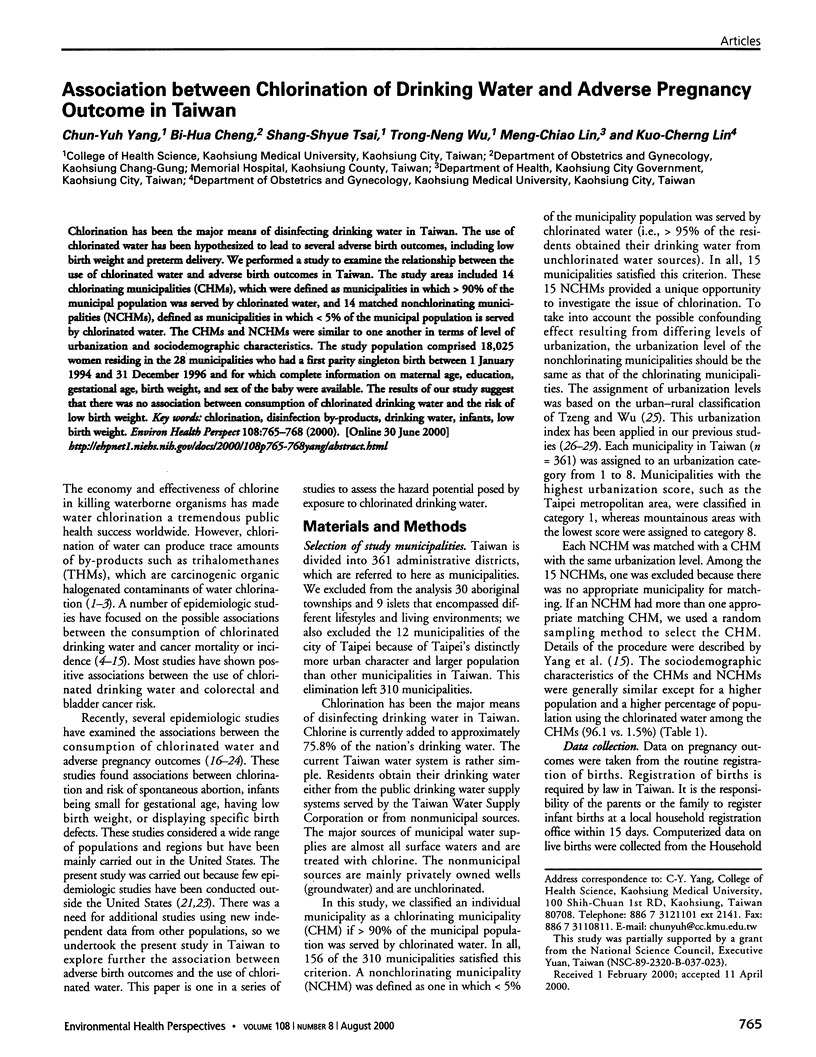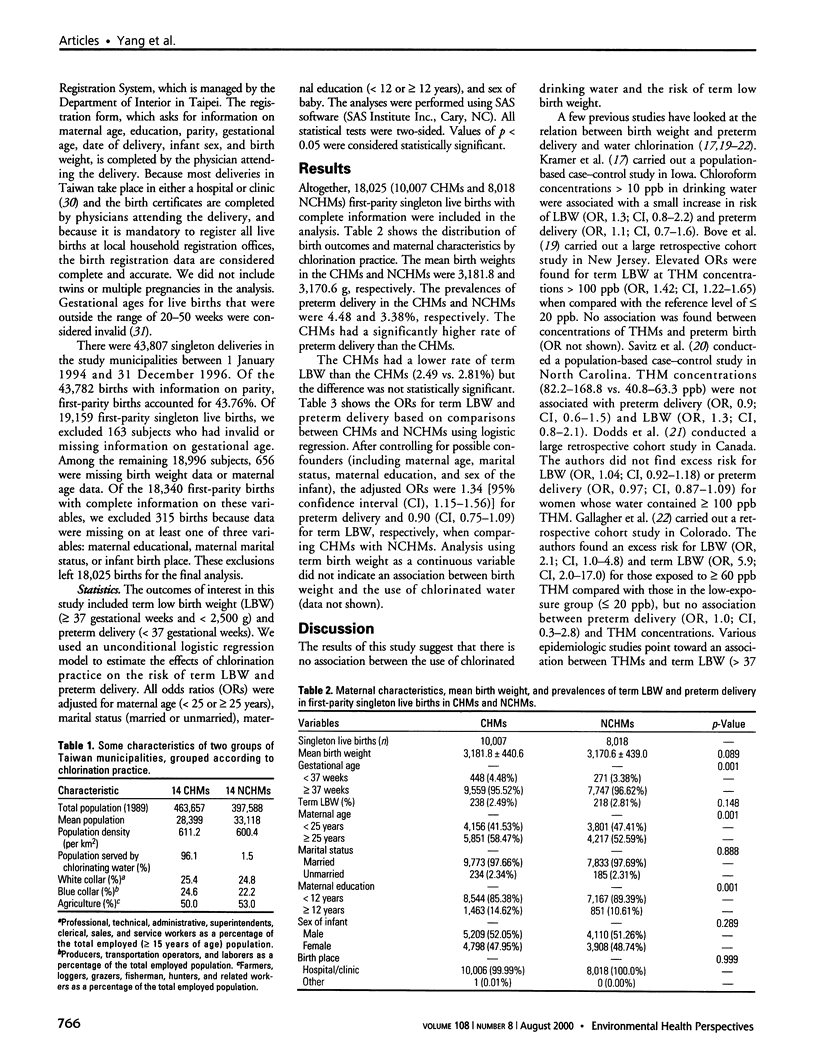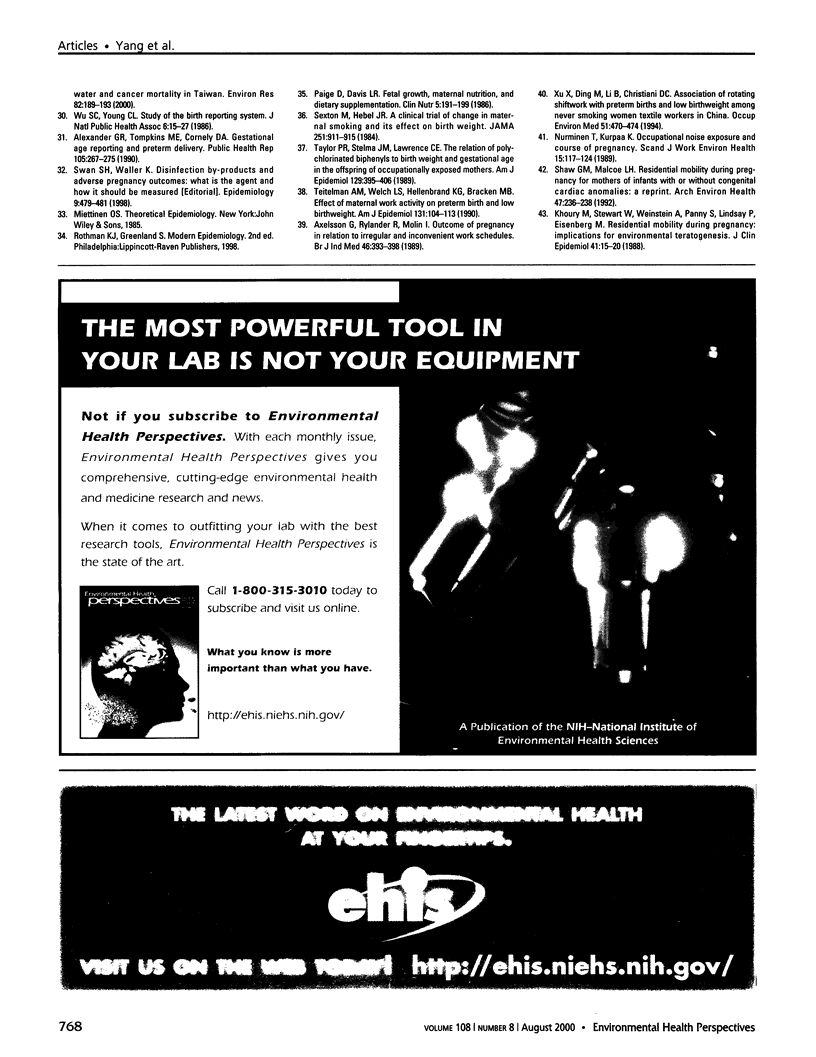Abstract
Chlorination has been the major means of disinfecting drinking water in Taiwan. The use of chlorinated water has been hypothesized to lead to several adverse birth outcomes, including low birth weight and preterm delivery. We performed a study to examine the relationship between the use of chlorinated water and adverse birth outcomes in Taiwan. The study areas included 14 chlorinating municipalities (CHMs), which were defined as municipalities in which > 90% of the municipal population was served by chlorinated water, and 14 matched nonchlorinating municipalities (NCHMs), defined as municipalities in which < 5% of the municipal population is served by chlorinated water. The CHMs and NCHMs were similar to one another in terms of level of urbanization and sociodemographic characteristics. The study population comprised 18,025 women residing in the 28 municipalities who had a first parity singleton birth between 1 January 1994 and 31 December 1996 and for which complete information on maternal age, education, gestational age, birth weight, and sex of the baby were available. The results of our study suggest that there was no association between consumption of chlorinated drinking water and the risk of low birth weight.
Full text
PDF



Selected References
These references are in PubMed. This may not be the complete list of references from this article.
- Alexander G. R., Tompkins M. E., Cornely D. A. Gestational age reporting and preterm delivery. Public Health Rep. 1990 May-Jun;105(3):267–275. [PMC free article] [PubMed] [Google Scholar]
- Aschengrau A., Zierler S., Cohen A. Quality of community drinking water and the occurrence of late adverse pregnancy outcomes. Arch Environ Health. 1993 Mar-Apr;48(2):105–113. doi: 10.1080/00039896.1993.9938403. [DOI] [PubMed] [Google Scholar]
- Axelsson G., Rylander R., Molin I. Outcome of pregnancy in relation to irregular and inconvenient work schedules. Br J Ind Med. 1989 Jun;46(6):393–398. doi: 10.1136/oem.46.6.393. [DOI] [PMC free article] [PubMed] [Google Scholar]
- Bean J. A., Isacson P., Hausler W. J., Jr, Kohler J. Drinking water and cancer incidence in Iowa. I. Trends and incidence by source of drinking water and size of municipality. Am J Epidemiol. 1982 Dec;116(6):912–923. doi: 10.1093/oxfordjournals.aje.a113493. [DOI] [PubMed] [Google Scholar]
- Bove F. J., Fulcomer M. C., Klotz J. B., Esmart J., Dufficy E. M., Savrin J. E. Public drinking water contamination and birth outcomes. Am J Epidemiol. 1995 May 1;141(9):850–862. doi: 10.1093/oxfordjournals.aje.a117521. [DOI] [PubMed] [Google Scholar]
- Cantor K. P., Hoover R., Hartge P., Mason T. J., Silverman D. T., Altman R., Austin D. F., Child M. A., Key C. R., Marrett L. D. Bladder cancer, drinking water source, and tap water consumption: a case-control study. J Natl Cancer Inst. 1987 Dec;79(6):1269–1279. [PubMed] [Google Scholar]
- Carpenter L. M., Beresford S. A. Cancer mortality and type of water source: findings from a study in the UK. Int J Epidemiol. 1986 Sep;15(3):312–320. doi: 10.1093/ije/15.3.312. [DOI] [PubMed] [Google Scholar]
- Cech I., Holguin A. H., Littell A. S., Henry J. P., O'Connell J. Health significance of chlorination byproducts in drinking water: the Houston experience. Int J Epidemiol. 1987 Jun;16(2):198–207. doi: 10.1093/ije/16.2.198. [DOI] [PubMed] [Google Scholar]
- Dodds L., King W., Woolcott C., Pole J. Trihalomethanes in public water supplies and adverse birth outcomes. Epidemiology. 1999 May;10(3):233–237. [PubMed] [Google Scholar]
- Dunnick J. K., Melnick R. L. Assessment of the carcinogenic potential of chlorinated water: experimental studies of chlorine, chloramine, and trihalomethanes. J Natl Cancer Inst. 1993 May 19;85(10):817–822. doi: 10.1093/jnci/85.10.817. [DOI] [PubMed] [Google Scholar]
- Flaten T. P. Chlorination of drinking water and cancer incidence in Norway. Int J Epidemiol. 1992 Feb;21(1):6–15. doi: 10.1093/ije/21.1.6. [DOI] [PubMed] [Google Scholar]
- Gallagher M. D., Nuckols J. R., Stallones L., Savitz D. A. Exposure to trihalomethanes and adverse pregnancy outcomes. Epidemiology. 1998 Sep;9(5):484–489. [PubMed] [Google Scholar]
- Gottlieb M. S., Carr J. K., Clarkson J. R. Drinking water and cancer in Louisiana. A retrospective mortality study. Am J Epidemiol. 1982 Oct;116(4):652–667. doi: 10.1093/oxfordjournals.aje.a113448. [DOI] [PubMed] [Google Scholar]
- Khoury M. J., Stewart W., Weinstein A., Panny S., Lindsay P., Eisenberg M. Residential mobility during pregnancy: implications for environmental teratogenesis. J Clin Epidemiol. 1988;41(1):15–20. doi: 10.1016/0895-4356(88)90004-2. [DOI] [PubMed] [Google Scholar]
- Kramer M. D., Lynch C. F., Isacson P., Hanson J. W. The association of waterborne chloroform with intrauterine growth retardation. Epidemiology. 1992 Sep;3(5):407–413. doi: 10.1097/00001648-199209000-00005. [DOI] [PubMed] [Google Scholar]
- Lawrence C. E., Taylor P. R., Trock B. J., Reilly A. A. Trihalomethanes in drinking water and human colorectal cancer. J Natl Cancer Inst. 1984 Mar;72(3):563–568. [PubMed] [Google Scholar]
- Magnus P., Jaakkola J. J., Skrondal A., Alexander J., Becher G., Krogh T., Dybing E. Water chlorination and birth defects. Epidemiology. 1999 Sep;10(5):513–517. [PubMed] [Google Scholar]
- McGeehin M. A., Reif J. S., Becher J. C., Mangione E. J. Case-control study of bladder cancer and water disinfection methods in Colorado. Am J Epidemiol. 1993 Oct 1;138(7):492–501. doi: 10.1093/oxfordjournals.aje.a116883. [DOI] [PubMed] [Google Scholar]
- Morris R. D., Audet A. M., Angelillo I. F., Chalmers T. C., Mosteller F. Chlorination, chlorination by-products, and cancer: a meta-analysis. Am J Public Health. 1992 Jul;82(7):955–963. doi: 10.2105/ajph.82.7.955. [DOI] [PMC free article] [PubMed] [Google Scholar]
- Nurminen T., Kurppa K. Occupational noise exposure and course of pregnancy. Scand J Work Environ Health. 1989 Apr;15(2):117–124. doi: 10.5271/sjweh.1873. [DOI] [PubMed] [Google Scholar]
- Reuber M. D. Carcinogenicity of chloroform. Environ Health Perspect. 1979 Aug;31:171–182. doi: 10.1289/ehp.7931171. [DOI] [PMC free article] [PubMed] [Google Scholar]
- Savitz D. A., Andrews K. W., Pastore L. M. Drinking water and pregnancy outcome in central North Carolina: source, amount, and trihalomethane levels. Environ Health Perspect. 1995 Jun;103(6):592–596. doi: 10.1289/ehp.95103592. [DOI] [PMC free article] [PubMed] [Google Scholar]
- Sexton M., Hebel J. R. A clinical trial of change in maternal smoking and its effect on birth weight. JAMA. 1984 Feb 17;251(7):911–915. [PubMed] [Google Scholar]
- Shaw G. M., Malcoe L. H., Milea A., Swan S. H. Chlorinated water exposures and congenital cardiac anomalies. Epidemiology. 1991 Nov;2(6):459–460. [PubMed] [Google Scholar]
- Shaw G. M., Malcoe L. H. Residential mobility during pregnancy for mothers of infants with or without congenital cardiac anomalies: a reprint. Arch Environ Health. 1992 May-Jun;47(3):236–238. doi: 10.1080/00039896.1992.9938355. [DOI] [PubMed] [Google Scholar]
- Swan S. H., Waller K. Disinfection by-products and adverse pregnancy outcomes: what is the agent and how should it be measured? Epidemiology. 1998 Sep;9(5):479–481. doi: 10.1097/00001648-199809000-00001. [DOI] [PubMed] [Google Scholar]
- Taylor P. R., Stelma J. M., Lawrence C. E. The relation of polychlorinated biphenyls to birth weight and gestational age in the offspring of occupationally exposed mothers. Am J Epidemiol. 1989 Feb;129(2):395–406. doi: 10.1093/oxfordjournals.aje.a115143. [DOI] [PubMed] [Google Scholar]
- Teitelman A. M., Welch L. S., Hellenbrand K. G., Bracken M. B. Effect of maternal work activity on preterm birth and low birth weight. Am J Epidemiol. 1990 Jan;131(1):104–113. doi: 10.1093/oxfordjournals.aje.a115463. [DOI] [PubMed] [Google Scholar]
- Waller K., Swan S. H., DeLorenze G., Hopkins B. Trihalomethanes in drinking water and spontaneous abortion. Epidemiology. 1998 Mar;9(2):134–140. [PubMed] [Google Scholar]
- Xu X., Ding M., Li B., Christiani D. C. Association of rotating shiftwork with preterm births and low birth weight among never smoking women textile workers in China. Occup Environ Med. 1994 Jul;51(7):470–474. doi: 10.1136/oem.51.7.470. [DOI] [PMC free article] [PubMed] [Google Scholar]
- Yang C. Y., Cheng M. F., Tsai S. S., Hung C. F. Fluoride in drinking water and cancer mortality in Taiwan. Environ Res. 2000 Mar;82(3):189–193. doi: 10.1006/enrs.1999.4018. [DOI] [PubMed] [Google Scholar]
- Yang C. Y., Chiu H. F., Cheng M. F., Tsai S. S. Chlorination of drinking water and cancer mortality in Taiwan. Environ Res. 1998 Jul;78(1):1–6. doi: 10.1006/enrs.1997.3823. [DOI] [PubMed] [Google Scholar]
- Yang C. Y., Chiu H. F., Chiu J. F., Kao W. Y., Tsai S. S., Lan S. J. Cancer mortality and residence near petrochemical industries in Taiwan. J Toxicol Environ Health. 1997 Feb 21;50(3):265–273. [PubMed] [Google Scholar]
- Yang C. Y., Chiu J. F., Chiu H. F., Wang T. N., Lee C. H., Ko Y. C. Relationship between water hardness and coronary mortality in Taiwan. J Toxicol Environ Health. 1996 Sep;49(1):1–9. doi: 10.1080/009841096160952. [DOI] [PubMed] [Google Scholar]
- Yang C. Y., Chiu J. F., Lin M. C., Cheng M. F. Geographic variations in mortality from motor vehicle crashes in Taiwan. J Trauma. 1997 Jul;43(1):74–77. doi: 10.1097/00005373-199707000-00017. [DOI] [PubMed] [Google Scholar]
- Young T. B., Wolf D. A., Kanarek M. S. Case-control study of colon cancer and drinking water trihalomethanes in Wisconsin. Int J Epidemiol. 1987 Jun;16(2):190–197. doi: 10.1093/ije/16.2.190. [DOI] [PubMed] [Google Scholar]
- Zierler S., Feingold L., Danley R. A., Craun G. Bladder cancer in Massachusetts related to chlorinated and chloraminated drinking water: a case-control study. Arch Environ Health. 1988 Mar-Apr;43(2):195–200. doi: 10.1080/00039896.1988.9935853. [DOI] [PubMed] [Google Scholar]


